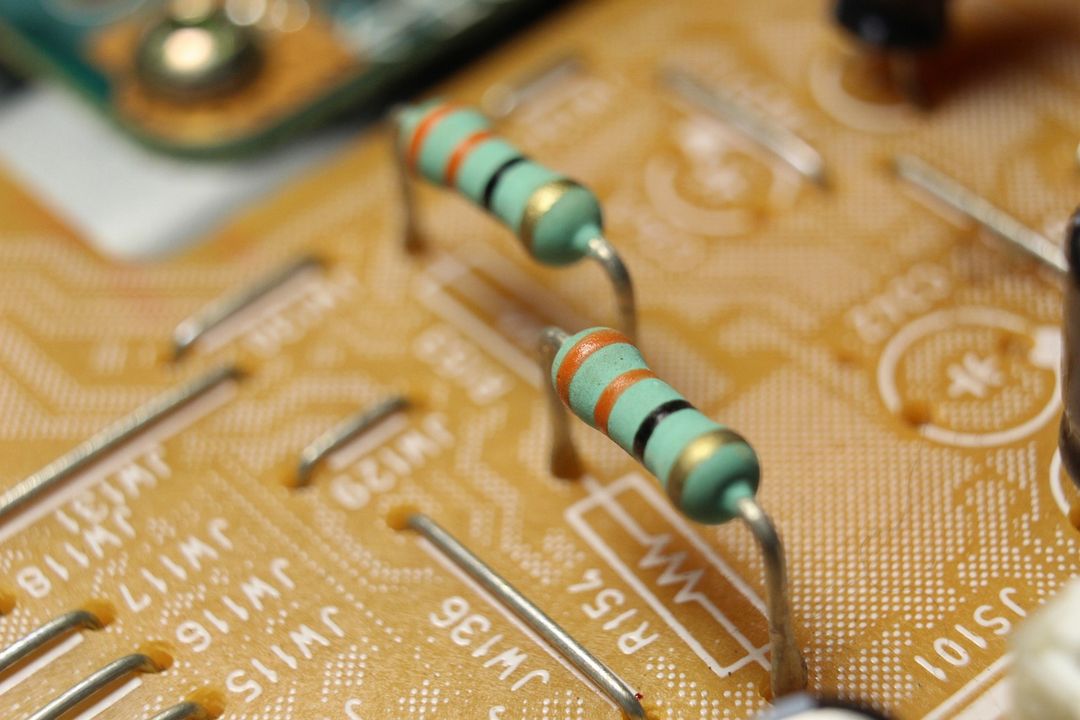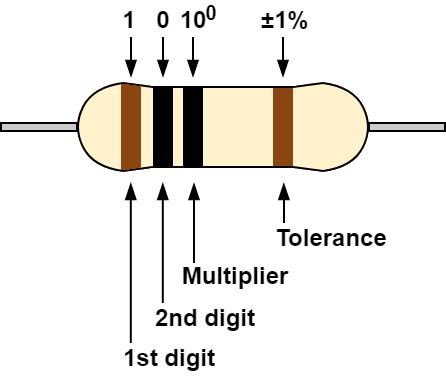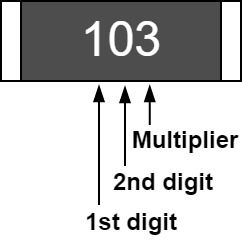How to Read Resistance Values

This article details how to read the resistance values of "axial leaded resistors" and "chip resistors".
E series
Resistance values are determined along the E series as follows.
The "E" in the E series stands for exponent, and the E12 series is completed by inserting the numbers 0 to 11 (12 numbers) into the "n" of the E12 series.
For resistors with an tolerance of ±10[%], using the E12 series values, 100[Ω] is 90 to 110[Ω], 120[Ω] is 108 to 132[Ω], and 150[Ω] is 135 to 165[Ω], so that the tolerance ranges overlap.
However, if the E series is too large, many types of resistors must be available, so the selection is usually made from the E12 series.
E6/E12/E24 seris
| E6 ±20% $\sqrt[6]{10^n}$ | E12 ±10% $\sqrt[12]{10^n}$ | E24 ±5% $\sqrt[24]{10^n}$ |
|---|---|---|
| 1.0 | 1.0 | 1.0 |
| 1.1 | ||
| 1.2 | 1.2 | |
| 1.3 | ||
| 1.5 | 1.5 | 1.5 |
| 1.6 | ||
| 1.8 | 1.8 | |
| 2.0 | ||
| 2.2 | 2.2 | 2.2 |
| 2.4 | ||
| 2.7 | 2.7 | |
| 3.0 | ||
| 3.3 | 3.3 | 3.3 |
| 3.6 | ||
| 3.9 | 3.9 | |
| 4.3 | ||
| 4.7 | 4.7 | 4.7 |
| 5.1 | ||
| 5.6 | 5.6 | |
| 6.2 | ||
| 6.8 | 6.8 | 6.8 |
| 7.5 | ||
| 8.2 | 8.2 | |
| 9.1 |
Color Code(Axial Lead Resistor)

Axial lead resistors are indicated by a color that represents a number as shown below.
Color Code
| Color | 1st digit | 2nd digit | 3rd digit | Multiplier | Tolerance | PPM |
|---|---|---|---|---|---|---|
| Black | 0 | 0 | 0 | $10^0$ | - | 250[ppm/K] |
| Brown | 1 | 1 | 1 | $10^1$ | ±1[%] | 100[ppm/K] |
| Red | 2 | 2 | 2 | $10^2$ | ±2[%] | 50[ppm/K] |
| Orange | 3 | 3 | 3 | $10^3$ | ±0.05[%] | 15[ppm/K] |
| Yellow | 4 | 4 | 4 | $10^4$ | ±0.02[%] | 25[ppm/K] |
| Green | 5 | 5 | 5 | $10^5$ | ±0.5[%] | 20[ppm/K] |
| Blue | 6 | 6 | 6 | $10^6$ | ±0.25[%] | 10[ppm/K] |
| Purple | 7 | 7 | 7 | $10^7$ | ±0.1[%] | 5[ppm/K] |
| Gray | 8 | 8 | 8 | $10^8$ | ±0.01[%] | 1[ppm/K] |
| White | 9 | 9 | 9 | $10^9$ | - | - |
| Gold | - | - | - | $10^{-1}$ | ±5[%] | - |
| Silver | - | - | - | $10^{-2}$ | ±10[%] | - |
| None | - | - | - | - | ±20[%] | - |
Some mnemonics that are easy to remember:
Easy to remember of color code
| Color | Number | First Letter |
|---|---|---|
| Black | 0 | Black |
| Brown | 1 | Brown |
| Red | 2 | Red |
| Orange | 3 | Orange |
| Yellow | 4 | Yellow |
| Green | 5 | Green |
| Blue | 6 | Blue |
| Purple | 7 | Purple |
| Gray | 8 | Gray |
| White | 9 | White |
| Gold | - | |
| Silver | - | |
| None | - |
Easy to remember
Big Boys Race Our Young Girls But Violet Generally Wins.
Better Be Right Or Your Great Big Venture Goes West.
Beetle Bailey Runs Over Your General Before Very Good Witnesses.
Beach Bums Rarely Offer You Gatorade But Very Good Water.
Buster Brown Races Our Young Girls But Violet Generally Wins.
Better Be Right Or Your Great Big Vacation Goes Wrong.
Better Be Right Or Your Great Big Values Go Wrong.
Better Be Right Or Your Great Big Plan Goes Wrong. (with P = Purple for Violet)
Back-Breaking Rascals Often Yield Grudgingly But Virtuous Gentlemen Will Give Shelter Nobly. (with tolerance bands Gold, Silver or None)
Better Be Right Or Your Great Big Plan Goes Wrong - Go Start Now!
Black Beetles Running Over Your Garden Bring Very Grey Weather.
Bad Booze Rots Our Young Guts But Vodka Goes Well – get some now.
Bad Boys Run Over Yellow Gardenias Behind Victory Garden Walls.
Bat Brained Resistor Order You Gotta Be Very Good With.
Betty Brown Runs Over Your Garden But Violet Gingerly Walks.
Big Beautiful Roses Occupy Your Garden But Violets Grow Wild.
Big Brown Rabbits Often Yield Great Big Vocal Groans When Gingerly Slapped Needlessly.
Black Bananas Really Offend Your Girlfriend But Violets Get Welcomed.
Black Birds Run Over Your Gay Barely Visible Grey Worms.
Badly Burnt Resistors On Your Ground Bus Void General Warranty.
Billy Brown Ran Out Yelling Get Back Violets Getting Wet.
Better Be Right Or You're Gonna Be Violently Gouged With Golden Spaghetti.
Bright Boys Rave Over Young Girls But Veto Getting Wed.
Black Bears Raid Our Yellow Green Bins Violently Grabbing Whatever Goodies Smell Nice.
Bad Bears Raid Our Yummy Grub But Veto Grey Waffles.
Bachelor Boys Rush Our Young Girls But Veronica Goes Wild for Gold or Silver Necklaces.
List of electronic color code mnemonics
Example:4 Band Resistor(3 Band Resistor)

- 1st digit:1(Brown)
- 2nd digit:0(Black)
- Multiplier:$10^0$(Black)
- Tolerance:±1[%](Brown)
- Resistance Value:$$10 \times 10^0=10[Ω]±1[\%]$$
The 4 band resistor is the most common marking used in the E3/E6/E12/E24 series.The color code of the tolerance may be closer to one side or thicker to distinguish it from other color codes.

- 1st digit:1(Brown)
- 2nd digit:0(Black)
- Multiplier:$10^0$(Black)
- Tolerance:±20[%](None)
- Resistance Value:$$10 \times 10^0=10[Ω]±20[\%]$$
The "brown-black-black" will be 10[Ω]. Since the tolerance is colorless, it represents ±20[%] and the number of resistor bands is 3.
Example:5 Band Resistor

- 1st digit:4(Yellow)
- 2nd digit:7(Purple)
- 3rd digit:0(Black)
- Multiplier:$10^2$(Red)
- Tolerance:±5[%](Gold)
- Resistance Value:$$470 \times 10^2=47[kΩ]±5[\%]$$
The 5 band resistor uses a 3rd digit in addition to the 1st and 2nd digits to accommodate the E96/192 series.
Example:6 Band Resistor

- 1st digit:6(Blue)
- 2nd digit:8(Gray)
- 3rd digit:0(Black)
- Multiplier:$10^3$(Orange)
- Tolerance:±0.5[%](Green)
- PPM:250[ppm/K](Black)
- Resistance Value:$$680 \times 10^3=680[kΩ]±0.5[\%], 250[ppm/K]$$
The 6 band resistor adds a band for the temperature coefficient.
Example:0Ω Resistor

- 1st digit:0(Black)
- Resistance Value:$$0[Ω]$$
The 0Ω resistor is marked with a black band in the center.
Digit Numbering(Chip Resistor)

Chip resistors are indicated by numbers as follows, which is easier to understand than color codes. In addition to numbers, there are also special markings such as R (decimal point) and L (mΩ and decimal point).
Note that if the size is less than 1005, it will be no description, and the only way to measure it is with a tester.
Digit Numbering
| 1st digit | 2nd digit | 3rd digit | Multiplier |
|---|---|---|---|
| 0 | 0 | 0 | $10^0$ |
| 1 | 1 | 1 | $10^1$ |
| 2 | 2 | 2 | $10^2$ |
| 3 | 3 | 3 | $10^3$ |
| 4 | 4 | 4 | $10^4$ |
| 5 | 5 | 5 | $10^5$ |
| 6 | 6 | 6 | $10^6$ |
| 7 | 7 | 7 | $10^7$ |
| 8 | 8 | 8 | $10^8$ |
| 9 | 9 | 9 | $10^9$ |
| R(Decimal Point) | R(Decimal Point) | R(Decimal Point) | - |
| L($10^{-3}$/Decimal Point) | L($10^{-3}$/Decimal Point) | L($10^{-3}$/Decimal Point) | L($10^{-3}$) |
Simplified Resistor Chart
Simplified Resistor Chart
| Example | Resistance Value |
|---|---|
| 106 | 10[MΩ] |
| 105 | 1[MΩ] |
| 104 | 100[kΩ] |
| 103 | 10[kΩ] |
| 102 | 1[kΩ] |
| 101 | 100[Ω] |
| 100 | 10[Ω] |
| 1R0 | 1[Ω] |
| R10 | 0.1[Ω] |
Example:3 digits Resistor

- 1st digit:1
- 2nd digit:0
- Multiplier:$10^3$
- Resistance Value:$$10 \times 10^3=10000[Ω]=10[kΩ]$$
The 3 digits resistor is used for the E3/E6/E12/E24 series.

- 1st digit:1
- Decimal Point:R
- 2nd digit:2
- Resistance Value:$$1.2=1.2[Ω]$$
The decimal point "R" is indicated between the numbers. In this case, no multiplier is indicated.

- 1st digit:1
- 2nd digit:2
- Multiplier:L($10^{-3}$)
- Resistance Value:$$12 \times 10^{-3}=12[mΩ]$$
Since there is an "L" at the end, the multiplier is set to $10^{-3}$.

- 1st digit:1
- Decimal Point:L
- 2nd digit:2
- Multiplier:L($10^{-3}$)
- Resistance Value:$$1.2 \times 10^{-3}=1.2[mΩ]$$
The "L" is between the numbers, indicating both a decimal point and a $10^{-3}$.
Example:4 digits Resistor

- 1st digit:1
- 2nd digit:0
- 3rd digit:0
- Multiplier:$10^2$
- Resistance Value:$$100 \times 10^2=10000[Ω]=10[kΩ]$$
The 4 digits resistor is used for the E96/E192 series. resistor "1002" is the same value as resistor "103".

- Decimal Point:R
- 1st digit:1
- 2nd digit:2
- 3rd digit:0
- Resistance Value:$$0.120=0.120[Ω]$$
The "R" indicating the decimal point is marked first. In this case, there is no multiplier marking.

- 1st digit:1
- 2nd digit:2
- Decimal Point:L
- 3rd dgit:0
- Multiplier:L($10^{-3}$)
- Resistance Value:$$12.0 \times 10^{-3}=12.0[mΩ]$$
The "L" is between the numbers, indicating both a decimal point and a $10^{-3}$.